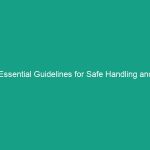Good Morning Team!
Today, we are diving into an important topic that affects all of us in the workplace: Essential Guidelines to Protect Against Silica Dust Exposure Risks. Understanding this topic is crucial for our health and Safety as we work in environments where silica dust can be present. By the end of our Toolbox Talk, you’ll have actionable steps to minimize your exposure and keep yourself and your coworkers safe.
Understanding Silica Dust Exposure Risks
Silica dust is a common hazard in many industries, especially construction, mining, and manufacturing. Silica, or silicon dioxide, is found in materials like sand, stone, concrete, and brick. When these materials are disturbed—such as during cutting, grinding, or drilling—silica particles can become airborne, leading to potential inhalation risks.
The importance of addressing silica dust exposure cannot be overstated. Prolonged inhalation of silica dust can cause serious health issues, including silicosis, lung cancer, and other respiratory diseases. These conditions can significantly impact your quality of life and ability to work. It’s essential to recognize this risk and understand how to protect ourselves effectively.
There are several misconceptions about silica dust. One common myth is that it only poses a threat to individuals working directly with concrete or stone. In reality, anyone working in or around these materials can be at risk if proper Precautions are not taken.
Key Hazards, Risks, and Safety Considerations
Let’s outline some specific Hazards and risks associated with silica dust exposure:
- Respiratory Issues: Inhaling silica dust can lead to chronic respiratory conditions, including silicosis.
- Increased Risk of Lung Cancer: Long-term exposure has been linked to an elevated risk of lung cancer.
- Autoimmune Disorders: Some studies suggest a connection between silica exposure and autoimmune diseases.
Ignoring safety protocols can lead to severe consequences, including chronic health issues that may require lengthy medical treatment, reduced work capacity, and even death in extreme cases. It’s not just about personal safety; it also impacts our team’s overall well-being and productivity.
Best Practices, Procedures, & Actionable Advice
Now that we understand the risks, let’s focus on Best Practices to minimize silica dust exposure:
1. Implement Engineering Controls
Whenever possible, use engineering controls to limit silica dust exposure:
- Water Suppression: Use water to dampen materials during cutting or grinding to prevent dust from becoming airborne.
- Ventilation Systems: Ensure proper ventilation in work areas to help disperse silica dust.
2. Personal Protective Equipment (PPE)
Wearing appropriate PPE is essential for reducing exposure:
- Respirators: Use N95 respirators or better to filter out harmful silica particles.
- Protective Clothing: Wear disposable or washable clothing to avoid carrying silica dust home.
3. Safe Work Practices
Adopting safe work practices can greatly reduce our risks:
- Training: Ensure all employees are trained on silica dust hazards and safe work practices.
- Regular Breaks: Take regular breaks in clean air to minimize prolonged exposure.
- Housekeeping: Implement a regular cleaning schedule to keep work areas free of dust.
Let me share a brief real-world incident: In a construction site, a worker was diagnosed with silicosis after years of unprotected exposure to silica dust. This case emphasizes the need for vigilance and the implementation of Safety Measures.
Regulations, Standards, and Compliance
Compliance with safety Regulations is not just a legal requirement; it’s a moral obligation to protect ourselves and our colleagues. The Occupational Safety and Health Administration (OSHA) has set permissible exposure limits (PEL) for silica dust. Understanding these limits and adhering to them is crucial for our safety.
Some important Standards include:
- osha’s Silica Standard (29 CFR 1926.1153) for construction includes requirements for exposure assessment, control methods, and Training.
- ISO standards related to Occupational Health and safety management systems.
Compliance with these regulations not only protects us but also fosters a culture of safety within our organization.
Employee Engagement & Discussion
Now that we’ve covered the risks and Safety Measures, let’s discuss them further. What safety challenges have you encountered related to silica dust? Do you feel adequately protected at work? Your feedback is invaluable, and sharing experiences can help us improve our safety practices.
Conclusion & Key Takeaways
In summary, protecting against silica dust exposure risks is a collective responsibility that requires awareness, proper safety measures, and adherence to regulations. Here are the key takeaways:
- Understand the hazards associated with silica dust.
- Implement engineering controls and use PPE.
- Adopt safe work practices and stay compliant with regulations.
Remember, your health and safety are paramount. Let’s prioritize these practices to ensure a safe working Environment for everyone. Thank you for your attention and commitment to safety today!


